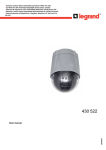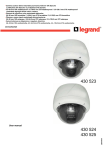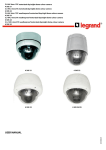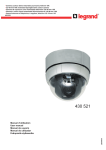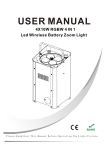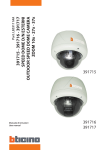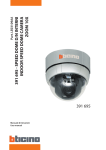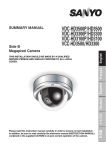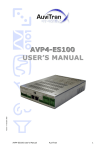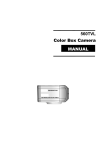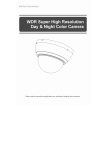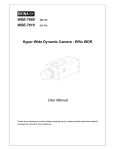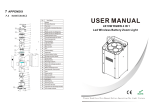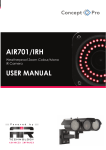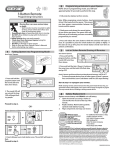Download User manual
Transcript
s¬Caméra couleur dôme motorisée jour/nuit 3,8-38 mm 10X s¬3.8-38 mm 10X motorized day/night dome colour camera s¬Cámara de cúpula en color motorizada día/noche 3,8-38 mm 10X s¬Câmara a cores cúpula motorizada diurna/nocturna 3,8-38 mm 10X s¬kamera kolorowa ze sklepieniem, z napędem, dzień/noc 3,8–38 mm 10X 430 521 430 521 LE03664AA User manual FEATURES s¬ Powerful Zoom Camera & Setup Options 10x Optical Zoom, 10x Digital Zoom (100x Max. zoom magnification) High light compensation Privacy Mask Day & Night Focus Mode : Auto-Focus, Manual Focus, Semi-Auto Focus OSD Menu Image Sensor : ¼” Sony interline Transfer CCD s¬ Powerful Pan/Tilt Functions ~ ~ ~ s¬ MAX. 360°/sec High Speed Pan/Tilt Motion With the Vector Drive Technology, Pan/Tilt motions are accomplished along the shortest path. As a result, the time to target view is remarkably short and the video on the monitor is very natural in monitoring. With the Micro-Stepping Control Technology, the video looks very natural at high zoom magnification during a jog operation on a controller since the camera can be controlled by 0.05°/sec. Hence it is very easy to make the camera focus on desired target views at high zoom magnification. Additionally it is easy to make the camera focus on desired positions with zoom-proportional pan/tilt movement. Preset, Pattern, Swing, Group, Privacy Mask and More… ~ ~ MAX. 127 Presets are programmable and each preset can have its own parameter values independently from the other presets. For an example, refer to the below table. Preset No. White Balance Auto Exposure Preset 1 Case A Case 3 “ENTRANCE” Preset 2 Case C Case 5 “WAREHOUSE” Preset 3 Case V Case 2 “OFFICE” - - Case K Case 9 sss Label Remarks ~~~ Preset 95 - - Reserved for OSD Menu ~~~ Preset 128 “TERRACE” ~ MAX. 8 sets of Swing are programmable. This function is that the camera moves repetitively between two preset positions at programmed speeds. ~ MAX. 4 Patterns are programmable. This function is that the camera memorizes the path (mostly curve path) by the joystick of the controller and revives the trajectory operated by the joystick as closely as possible. ~ MAX. 8 sets of Group are programmable. This function is that the camera memorizes the combination of Presets, Pattern and/or Swings sequently and runs Presets, Pattern and/or Swings repetitively. A Group can be combined upto 20 functions with any of Preset/Pattern/Swing. ~ 4 Privacy Masks are programmable, not to intrude on any other’s privacy : 2 s¬ PTZ (Pan/Tilt/Zoom) Control ~ With the RS-485 communication connection, MAX. 255 units of cameras can be connected to a single controller. ~ Pelco-D or Pelco-P protocols can be selected as a control protocol in the current firmware version. s¬ OSD (On Screen Display) Menu ~ ~ OSD menu is provided to display the status of camera and to configure the functions interactively. The information such as Camera ID, Pan/Tilt Angle, Direction, Alarm Input and Preset is displayed on screen. s¬ Alarm In/Out Function ~ ~ ~ ~ 3 alarm sensor inputs and 1 alarm sensor outputs Alarm sensor input is decoupled with photo-couplers to avoid external electric noise and shock perfectly. Both of N.O.(Normal Open) sensors and N.C.(Normal Close) sensors can be used and the signal range of the sensor input is from DC 5.0V to 12.0V for various applications. The camera can be set to move to a Preset position or to run functions such as Pattern, Swing and Group when there are external sensor activations. Also “Post Alarm” function is possible, which is supposed to activate after user-defined time period and sequentially in succession to the action by external sensor activations. s¬ Reserved Presets (Hot Keys) ~ Most camera setup options can be set up easily and directly with the reserved presets (Hot Keys), without entering into OSD menu. For more information, refer to “Reserved Presets (Hot Keys)”. Warning - The installation and calibration of this camera must be carried out by highly skilled personnel. - Do not open the camera: there may be a risk of electric shock. - Low voltage cameras must be powered by a power supply unit with stabilized voltage. This range of cameras has been created for CCTV applications and not for other uses. Use these cameras only for the following temperature conditions: from (-10) – (+50) °C. Do not use the cameras with voltages different from the ones specified. Safety instructions This product should be installed in line with installation rules, preferably by a qualified electrician. Incorrect installation and use can lead to risk of electric shock or fire. Before carrying out the installation, read the instructions and take account of the product’s specific mounting location. Do not open up, dismantle, alter or modify the device except where specifically required to do so by the instructions. All Legrand products must be opened and repaired exclusively by personnel trained and approved by Legrand. Any unauthorised opening or repair completely cancels all liabilities and the rights to replacement and guarantees. Use only Legrand brand accessories. 3 PACKAGE COMPONENT s¬ Product & Accessories 4 MAIN PART DESCRIPTION s¬ Product & Accessories Surface Mount B racket Mounting Screw Hole Main Connector Sensor I/O Port Dome Cover A ssembly Stud DIP Switch Dome Cover L ock-up Screw Dome Cover ~ Dome Cover Do not detach the protection vinyl from the dome cover before finishing all the installation process to protect the dome cover from scratches or dust. ~ Dome Cover Lock-up Screw Used to lock up the dome cover after assembling the dome cover with the main body. ~ Dome Cover Assembly Stud Used to line up the stud on the main body and the stud on the dome cover when assembling the dome cover with the main body. ~ DIP Switch Used to set up camera IDs and protocols. ~ Surface Mount Bracket & Mounting Screw Hole Used for surface mount type, wall mount type and ceiling mount type. They are not used for in-ceiling mount type. ~ Main Connector Used for the power wire, the video cable and the RS-485 communication cable connection. ~ Sensor I/O Port Used for the sensor in/out connection. 5 DIP SWITCH SETUP Before installing the camera, set up the DIP switch to configure the camera ID and the communication protocol. s¬ Product & Accessories s¬ Camera ID Setup ~ ~ ~ ~ ~ ~ DID numbers of cameras are set up with binary numbers. See the examples shown below. Pin 1 2 3 4 5 6 7 8 Binary Value 1 2 4 8 16 32 64 128 ex: ID = 5 ex: ID = 10 on off off on on off off on off off off off off off off off The camera ID range is “1~255”. Camera ID must not be “0”! The factory default of the camera ID is “1”. Match the camera ID with the Cam ID setting of your DVR or Controller to control the camera. If you are connecting a single camera to a controller, terminate the camera. When connecting more than one camera to a single controller, terminate the last camera on the communication line. The last camera means the camera farthest in cable length from the controller. Note that the total length of the communication cable between a controller and the camera(s) on the same communication line must be less than 1.2Km. 6 s¬ Communication Protocol Setup ~ Select an appropriate Protocol with the DIP switch combination. Switch Mode P0 (Pin 1) P1 (Pin 2) P2 (Pin 3) Protocol OFF OFF OFF PELCO-D, 2400 bps ON OFF OFF PELCO-D, 9600 bps OFF ON OFF PELCO-P, 4800 bps ON ON OFF PELCO-P, 9600 bps Others Reserved ~ Match the camera protocol with the camera protocol in the setting of your DVR or controller to control the camera. ~ Adjust the DIP switch after turning off the camera. If you changed the camera protocol by changing the DIP S/W, the change will be effective after you reboot the camera. The factory default protocol is “Pelco-D, 2400 bps”. s¬ Terminal Resistor Setup ~ The terminal resistor is used for the following cases. s¬ Case 1 : In case that the control cable length between a camera and a controller is relatively very long (1:1 Connection) If the communication cable length is very long, the electrical signal will bound in the terminal point. This reflected signal causes distortion of original signal. Accordingly, the camera can be out of control. In this case, the terminal resistor of both sides i.e. the camera and the controller must be set to ‘ON’ state. s¬ Case 2 : In case that multiple cameras are connected to a controller. Due to similar reasons with the case 1, the terminal resister of the controller and the last camera must be set to ‘ON’ state. The last camera means the camera farthest in cable length from the controller. Do not turn on the terminal resistor of all the cameras on the same communication cable. The complete informations are in the manual on the CDrom. 7 $$ $ IN-CEILING MOUNT INSTALLATION ! Remove the ceiling tile from the ceiling and cut a hole whose diameter is 110mm on the ceiling tile to pass the wires and cables through to the upside of ceiling. # Align the dome cover stud with the dome cover assembly stud and slightly push the dome cover to the ceiling tile. " Connect the wiring and cabling and attach the camera to the ceiling tile. (Tapping M4x16) '' ' $ Turn the dome cover clockwise and screw on the dome cover lock-up screw. Then remove the protection vinyl from the dome cover. (Machine M3x6) Important Notice ~ Before starting the installation, make sure that the Camera ID and Protocol are set up properly. 8 * INSTALLATION WITH SURFACE MOUNT BRACKET ! Remove the ceiling tile from the ceiling and cut a hole whose diameter is 30~40mm on the ceiling tile to pass the wires and cables through to the upside of the ceiling. (In case of wiring and cabling through the ceiling tile only) # Connect the wires and cables to the ports and install the main body. (Machine M3x8). * !! -- ! - " Prepare the surface mount bracket. Pull the wires and cables for the system as below. Attach the surface mount bracket to the mounting surface. (Tapping M4x25) $ Align the dome cover stud with the dome cover assembly stud and slightly push the dome cover to the ceiling. Turn the dome cover clockwise and screw on the dome cover lock-up screw. Then remove the protection vinyl from the dome cover. (Machine M3x6). Important Notice ~ ~ Before starting the installation, make sure that the Camera ID and Protocol are set up properly. When the pipe hole for wiring and cabling on side of the Surface Mount Bracket is not used, make sure that the hole is properly sealed with the supplied Hole Plug. 9 WIRING AND CABLING POWE R A UDI O MIC . SPE A K E R B NC MA I N C A B L E MONITOR C AB L E R S-485 I /O CA B L E C ONT R OL L E R / DV R SE NSOR I/O IR SE NSOR DOOR SWI TCH s¬ Port Description ~ Main Cable Port Pin Number (RJ45) 1 2,4 Connector / Wire Color BNC Connector Signal Video + Video - 5 Red RS-485 + 3 Yellow RS-485 - 7 Orange Power + 6,8 White Power - Port Pin Number (RJ25) Wire Color Signal 1 Blue IN COM + 2 Yellow IN 1- 3 Green IN 2 - 4 Red IN 3 - 5 Black OUT A 6 White OUT B Port Pin Number Connector/Wire Color Signal 1 RCA (Yellow) Audio IN ~ I/O Cable ~ Audio Cable 2 3 Audio GND RCA (White) 10 Audio OUT s¬ Power Description ~ Carefully check the voltage and current capacity of the rated power. The rated power is indicated in the back of main unit. Input Voltage Range Current Consumption DC 11V ~ 15V 0,8 A ~ For the DC input models, be careful with the polarity of DC power. The system should be permanentally damaged by wrong DC input. ~ In case that the length of the power wire is very long, there may be voltage drop and the syatem may not work properly. Make the length of the power wire as short as possible. s¬ RS-485 Communication ~ For PTZ control, connect the cable(s) to your keyboard or DVR. To connect multiple cameras to a single controller, RS-485 communication should be connected in parallel as shown below. If you are connecting a single camera to a controller, terminate the camera. When connecting more than one camera to a single controller, terminate the last camera on the communication line. The last camera means the camera farthest in cable length from the controller. Note that the total length of the communication cable between a controller and the camera(s) on the same communication line must be less than 1.2Km. s¬ Video ~ Use BNC coaxial cable only. 11 s¬ Alarm Input ~ Before connecting sensors, check driving voltages and output signal types of the sensors. Since output signal types of the sensors are divided into Open Collector type and Voltage Output type in general, the wiring must be done properly after considering those types. Signal IN COM+ Description The electric power source to drive input circuit. Connect the (+) wire of electric power source to drive the Sensors to this port as shown in the above circuit. IN1 -, IN2 -, Connect the outputs of sensors to each port as shown in the above circuit. IN3 - ~ If you want to use Alarm Input, the types of sensors must be selected in OSD menu. The sensor types are divided into Normal Open and Normal Close. If wrong sensor types are selected, alarms should be activated reversely to sensor inputs. Normal Open Output Voltage is high state when sensor is activated Normal Close Output Voltage is high state when sensor is not activated s¬ Relay Output ~ The maximum loads are as follows. Power Type DC Power Maximum Load MAX. DC 24V, 1A 12 CHECK POINTS BEFORE OPERATION ~ Before turning on the system, check if the wire(s) and cable(s) are connected properly. ~ Check if the camera ID on the controller is properly selected. The camera ID must be identical to that of the target camera. The camera ID can be checked by reading the DIP switch of the camera or on OSD. ~ If your controller supports multi-protocols, the protocol must be changed to match to that of the camera. ~ Adjust the DIP switch after turning off the camera. If you changed the camera protocol by changing the DIP S/W, the change will be effective after you reboot the camera. ~ Since the operation method can be different by controllers, refer to your controller manual if the camera can not be controlled properly. The operation of this manual is based on the standard Pelco® Controller. 13 SPECIFICATIONS CAMERA PART Video Signal Format PAL Image Sensor 1/4'' Interline Transfer CCD Total Pixels 795(H)x596(V) 470K Effective Pixels 752(H)x582(V) 440K Horizontal Resolution 500 TV Lines(Color), 570 TV Lines(B/W) Video Signal-to-Noise 50 dB (AGC Off) Zoom x10 Optical Zoom, x10 Digital Zoom Forcal Length F1.8, f=3.8~38mm Angle of View H : 51.2°(Wide)~5.58°(Tele) / V : 39.3°(Wide)~4.27°(Tele) Zoom Speed 1.75 sec (Wide to Tele) Minimum Illuminance 0.7 Lux (Color) / 0. 02 Lux (B/W), 50 IRE Day & Night Auto / Day / Night(ICR) Focus Auto / Manual / SemiAuto Iris Auto / Manual Shutter Speed x128 ~ 1/120000 sec AGC Normal / High / Off White Balance Auto / Manual(Red, Blue Gain Adjustable. 1800°K~10500°K) BLC Low / Middle / High / Off Flickerless Selectable SSNR Low / Middle / High / Off Privacy Zone 4 Masks, Spherical Coordinate MECHANISM PART Movement Range Speed Pan 360°(Endless) Tilt 90° Preset 360°/sec. Jog 0.05 ~ 360°/sec. (Proportional to Zoom) Swing 1~ 180°/sec. Preset 127 Presets (Label, Independent Camera Parameter Setting) Pattern 4 Patterns [1200 Commands(Approx. 5 Minute) / Pattern] Swing 8 Swings Group 8 Groups (MAX. 20 Actions with The Combination of Preset, Pattern and Swing) Other Pan/Tilt Functions Auto Flip, Auto Parking, Power Up Action and etc. Communication RS-485 Protocol Pelco-D, Pelco-P Selectable OSD English, Menu / PTZ information etc Sensor Input 3 Inputs, Photo-Coupler Type, DC 5V~12V Alarm Outputs 1 Output, Relay Output, MAX. Load DC24V 1A Fan Always ON Heater Operation Start from Internal Temperature 10°C Operation Temperature 0°C ~ 40°C 14 MECHANICAL Surface Mount Material Ceiling Mount Dome Polycarbonate Internal Polycarbonate, ABS External Polycarbonate Dome Size Ø 107,5 mm/ Ø 4,2” Dimension 132,4x129,5 mm 132,4 x 187,5 mm Weight (kg) Approx 0,7 Approx 0,8 [Note] Check the voltage and current capacity of rated power carefully. 15 DIMENSION s¬ Main Body s¬ Surface Mount Type 16 17 18 19




















